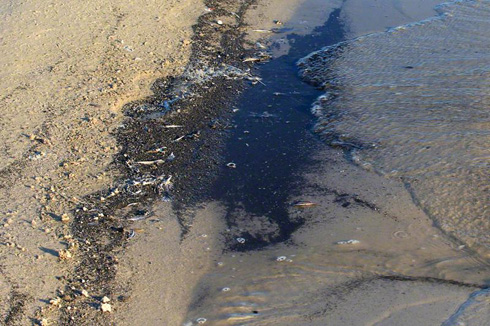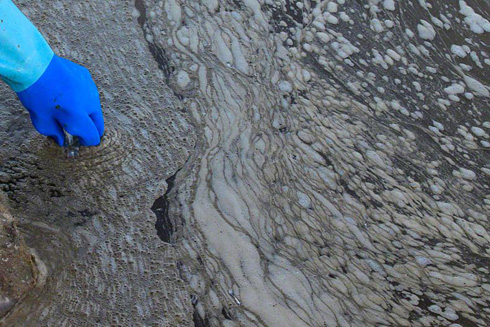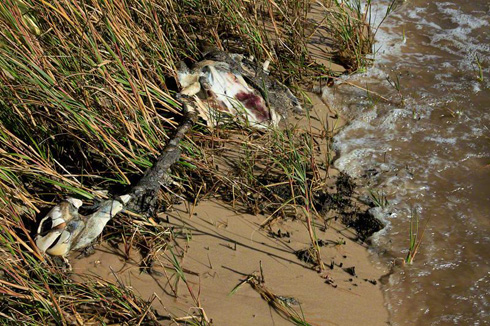PORT-AU-PRINCE, Haiti -- If people in L.A. all have a screenplay in their pockets, in Haiti, everyone's got a blueprint -- geodesic domes, Styrofoam cinder blocks, shipping container shacks. In the year since the earthquake, Haiti has become an architectural Eden, where no one has "plans" or "designs" -- just "solutions."
There are 800,000 homeless people here, 180,000 houses damaged and $5.7 billion pledged. All two hours from Miami. American entrepreneurs appeared in Haiti just days, and sometimes, hours after the earthquake. But they weren't the only ones.
Charities that never before set foot in Haiti appeared within hours -- photographers in tow and dollar signs in their eyes. Shelter is "sexy" humanitarian aid. Houses and tents are photographable. Try telling your donors, "We helped 100 people urinate in a toilet today!" or "The trash on the street is now in a pile!"
But for most, the easy deal never materialized. Though more than $1 billion has been spent in Haiti since the quake hit a year ago Wednesday, only about 1,000 permanent houses to replace the ones that crumbled have actually been built here. And none in Port-au-Prince, according to the United Nations Human Settlements Program, which tracks the numbers. At this rate, Haiti will be "Built Back Better" by the year 2110.
Land disputes, dysfunctional bureaucracies, battles over funding and fierce competition have made shelter the most clearly failed effort of the recovery in Haiti. The one key factor that keeps people from successfully building houses here? For the past year, I've found, no one has really tried.
Shrouded in the myth of "reconstruction," major aid groups have focused on the quick fix. Ingenuity and ambition -- those American ideals -- are still at bay in Haiti.
And at least one entrepreneur learned his lesson the hard way.
Arriving Full of Ideas, HopeIt's late July and I've just flashed my press badge and a smile to security at the airport. I've come to meet Ben Sandzer-Bell, a French-American businessman who is here to promote his bamboo eco-housing solution in Haiti.

Emily Troutman for AOL News
Ben Sandzer-Bell, who directs the company CO2 Bambu, arrived in Haiti with big ambitions. After setbacks, he's now adapted his plans.
Though we've never met, I spot him at the luggage carousel from 50 feet away -- the familiar dark glasses of an architect, fedora, worn leather bag that looks rained-on but probably cost him a paycheck. He sticks out among the missionaries and aid workers -- no cargo pants, no fanny pack.
This is Sandzer-Bell's second trip to Haiti and he's arrived for a whirlwind week of meetings. First, he will meet with the Lutheran World Federation, with whom he's secured a small contract; then, the Spanish Red Cross, which "looks promising"; then, a mind-boggling mix of charities, private businesses and consultants.
He's just one of hundreds who are trying to navigate the post-disaster market here. And if his ambitions can be ascertained from his schedule, he is awaited by a Herculean task -- get some contracts, convince them he needs the money up-front, figure out the whole customs thing, jump-start the bamboo industry, etc.
He arrives with a small envelope of bamboo seeds, painstakingly cultivated, he says, "worth their weight in gold." He has a vision of bamboo forests lining the hillsides of Haiti. Others may have tried that before and failed, but they used the wrong kind of bamboo, he says.
While I wait for Sandzer-Bell to find his bag, I chitchat with a group of young people who have arrived to Haiti in matching T-shirts. "Love Loud," the shirts say, with an icon of the cross, inside a map of Haiti, jutting, more or less, into the Gulf of Gonave.
"We're hoping to build some houses," 18-year-old Zack Jones says. "And spread the gospel."
His slow Texas drawl and sweet, Justin Bieber puppy eyes make everything seem possible. He travels with other young volunteers, including 20-year-old Mechelle Poche, who says her first trip abroad is going fine, "except I got a little dizzy when we first went up."
She means the plane, I finally realize -- it's her first time flying. And she wouldn't be here at all except that her mother thought if she's "gonna go somewhere better to go with Pastor John." The Rev. John Babler, to those of us who don't frequent Birchman Baptist Church in Fort Worth.
Sandzer-Bell arrives with his luggage and I follow him out of baggage claim. More accurately, I run ahead, eager to capture that one, timeless image: Traveling salesman meets Haiti.

Emily Troutman for AOL News
Zack Jones, an 18-year-old missionary from Fort Worth, Texas, arrives at Haiti's airport for a one-week trip. Unlike many others with big plans here, he actually built a house.
CO2 Bambu, based in Nicaragua, is what Sandzer-Bell calls a "triple bottom line" company -- affordable, good for the Earth, good for local populations. In this case, the local workers would be Nicaraguan, but no matter, once Haitians fall in love with bamboo, they'll want to grow it, too.
"I know I sound like I have a, what's the word? ... Messianic vision," he says, by way of introduction. "But believe me, if you talk to anybody in bamboo right now that's how they sound."
Well, not just the people in bamboo.
Everybody Has a 'Solution'Officials with every aid organization admit that at least some of their days are spent answering surprise house calls and e-mails from salesmen. Soon after the earthquake, it became a problem worth complaining about.
In an interview in July, U.N. Special Envoy Bill Clinton told Esquire magazine that he was bombarded with shelter "solution" e-mails. It seemed everyone in the world was suddenly an architect -- and a salesman. E-mails on humanitarian Listservs read like a Sears catalog.
"Light weight, fire resistant, soundproof," wrote William Danshin of his product, from Canada.
"Structural integrity, projected longevity, and sense of dignity," promised Sunit Doshi.
"Stronger, cheaper and prettier," said Tommy Sanford.
Pinecone, a company out of New Zealand, offered "The Turtle," as well as its variations, "Emergency Turtles," "Permanent Turtles" and "Enlarged Turtles."
In March, officials with the U.N. tried to organize the chaos. They created an alternate shelter coordination website for for-profit companies, discretely named "Shelter Solutions."
The objective of the new site was to push for-profits out of the game, not just because their products aren't "charitable," but also because they didn't know the rules. In the height of the disaster response, sales pitches seemed tacky. When they happened, it was in the language and culture of aid, not business.
In general, in Haiti, there's a lot of money at play, but people don't talk about payment, they say "funding." Instead of products, they say "relief items." Instead of business plans, they say "strategies." Funders are "partners." Failures are "delays."
The U.S. Agency for International Development (USAID) receives e-mails every day.
Just weeks after the earthquake, a frustrated business owner posted this form-letter response: "When Congressional funds are allocated, [USAID] will certainly be looking for partner organizations. ... Please watch the activities of the Shelter Cluster to learn more as the situation evolves."
It didn't take long for people to actually show up, looking for "partners."
Preaching the Gospel of BambooIt's day five of his journey and Ben Sandzer-Bell has just met with a representative from Save the Children. This is perhaps the 15th time he's given his 10-minute spiel on the benefits of bamboo, and the fifth time I've seen it.
From his duffel bag, Sandzer-Bell pulls out squares of bamboo walls, like carpet samples, to show how sturdy, well insulated, pretty, green and affordable they are. Lightweight, right? But strong too!
He reinforces the concept of the "triple bottom line." Then we watch a video about the bamboo forest he's growing in Nicaragua and at the end his humble staff stands in front of their product holding a Haitian flag. Someday, he says, this could be Haiti.
Sandzer-Bell is getting better at his pitch. He laughs and tells me he feels like a vacuum cleaner salesman. He's lucky, because in the end, it's a nice product. Save the Children seems excited about the prospect of bamboo houses. But like many eco-solutions, the product is expensive, much more expensive than plywood. Charities, like any other business, want bang for their buck.
Seven months after the earthquake, Save the Children tells Sandzer-Bell that it isn't in a position to talk about real houses. All the money is going to "transitional" schools. Like transitional houses, they are mostly made of plywood. Schools have been easier to build because land rights are less complicated.

Emily Troutman for AOL News
In Haiti, Sandzer-Bell arrives at an appointment with a charity, dragging his duffel bag of bamboo samples. He says he feels like a vacuum cleaner salesman.
"I thought we were in the walk, crawl, run stage," says Sandzer-Bell, speaking about what he's learned. "But really, it's the silence, silence, silence, oops we forgot about you, and as long as you're here you could probably give us a proposal on this ... stage."
The entrepreneur made inroads via e-mail from Nicaragua, but it seems every time he makes a good connection, his contact leaves. Most organizations, including the U.N., did not have the capacity to immediately dispatch a bunch of people to Haiti.
By the end of the meeting, Sandzer-Bell knows almost as much as he knew when it began. For now, Save the Children says, it will consider buying some of Sandzer-Bell's bamboo to insulate a transitional shelter. Actual houses are still a theory.
He didn't realize before coming here, he says, that there was such a huge intermediate market in transitional buildings. He already has one container with the materials for one house en route to Haiti. But in retrospect, he wishes he had sent wall materials and dispensed with the idea of selling charities on the actual house.
Sandzer-Bell assumed that with 1 million homeless people here, some of these charities would be building homes. Rookie mistake.
To Fish or Not to FishWhen entrepreneurs step off the plane in Port-au-Prince, whether they know it or not, they find themselves in the heart of an ages-old conflict in international assistance. It's the "teach a man to fish / give a man a fish" divide that has spurred decades of debate about the best way to serve people in need.
The international "assistance" community is firmly divided into two groups. One is "aid" and the other is "development." The distinction between aid and development is not just theoretical. They operate from two different philosophies and mandates. They are also paid out of different pockets.
"Aid" is focused on temporary relief from disaster and suffering -- for example, providing water or emergency doctors. "Development" is focused on long-term capacity building -- fixing the broken sewage system to provide clean water or training Haitian doctors to provide better services.

Emily Troutman for AOL News
In Port-au-Prince, Haiti, one family was lucky enough to receive a transitional shelter. They are confused, they say, by the lack of a toilet and walls. Each of these shelters costs between $1,000 and $1,500, the cost to repair a home.
Some organizations manage to do both very successfully. And, ultimately, both sets of needs are real and in some ways, different. People need clean water right away, but they also need clean water 10 years from now. Haiti, in particular, is considered a classic example of a country destroyed by aid and ignored by development.
In other words, too many free fish.
To address the immediate need for shelter in Haiti, the international aid community passed out 800,000 tarps. That took almost six months and cost about $40 million. About 98,000 tents also were passed out. That cost, on the low side, about $30 million.
No one really knows, in total, how much any of this cost. There is no organization or group that calculates the figures, in part, because there is no regulatory responsibility for aid groups to transparently disclose the costs.
But an analysis of the tents and tarps, conducted in May by Jon Ashmore, an independent consultant to the shelter coordination committee, provides some clues. Many organizations shared candid figures for his report and he published one actual budget from a charity on the ground. For a relatively cheap tent, one that cost about $100 in the U.S., the shipping, overhead and distribution costs added $150 more.
Once the aid organizations were done with tarps, they began to build "transitional" shelters -- one-room shacks with tin roofs, some with plywood walls and some with walls of tarps. Since last year, they have built 31,656, according to the U.N.
The shelters are temporary and will only last two to three years, theoretically, until people can build real houses. They cost about $1,000 to $1,500 each -- $1,500 is also, coincidentally, the exact amount that the Pan American Development Foundation says it costs to repair an earthquake-damaged house in Haiti.
In the meantime, organizations are replacing the first batch of tarps, which fell apart after six months in the sun.
Finding Reality on the GroundSandzer-Bell's biggest challenge to entering the market, he discovers, is not the inconsistencies or the lack of transparency or the simple fact that no one is trying to build real houses.
Even if he found someone who wanted to buy his bamboo house, his problem is the fierce competition over a set of fixed resources that is entirely monopolized by aid trucks, storage space and the slow process of customs approval.
If he could get his product into Haiti, then maybe, just maybe, he could sell it. In the meantime, he faces what the experts call "a logistical nightmare."

Emily Troutman for AOL News
In Cabaret, Haiti, Cheyenne, 2, stands outside a neighbor's house in a community that residents say was built by Food for the Poor in 1997 for the handicapped. It has fallen into disrepair. The community would like to fix the houses, but there are no jobs.
With so many charities operating in Haiti now, there is no warehouse space left. Inflation is rampant. The prices for real estate, food and equipment have gone up 30 to 200 percent. Car dealerships are out of cars. The government is out of license plates. Experts -- in everything -- are in short supply.
During his week in Haiti, Sandzer-Bell sets up a meeting with a logistics consultant. He's a chain-smoking, world-weary pro who has a reputation for getting things done. The expert says the docks are a mess -- the only way to get stuff in is through the Dominican Republic. And even then, it will cost.
Organizations, he says, often make "donations" to the "charities" of customs employees to grease the wheels. But that's more of a tithe than a bribe, since it hardly works. Sandzer-Bell takes copious notes and, despite the grim news, is still buoyed by the prospect of progress.
The whole enterprise, he says, appeals to him -- riding to meetings on the back of motorcycles through the dust and the sun, waiting for people who don't appear, sleuthing out the truth. It draws out equally, he says, his French side -- the charm, the
laissez-faire; and his American side -- the businessman, the ambition.
By December, however, Sandzer-Bell is less optimistic. By e-mail, he tells me, his containers never made it out of customs. Other home builders whose stories I followed echoed his experience.
'I've Seen This Movie Before'People think this is the first time anyone's tried to Build Back Better in Haiti. When the earthquake first hit, I met with a friend in Washington, D.C. He's an ex-political operative and spent many years in Haiti.
At the six-month anniversary of the quake, we met for coffee. I gave him the litany of events as I had witnessed them -- the white SUVs, the meetings about nothing, the rubble, the government stalling everything at the port, the money for aid but not development, the new fancy restaurants in town, tarps, transitional shelters, photo ops and more photo ops, mayors who do nothing but cause trouble.
He just looked into his cup of coffee and said slowly, "Yeah, I've seen this movie before."
Aid groups that claim to be building permanent shelters in Haiti are almost entirely addressing the needs that existed before the earthquake hit. They are building houses destroyed in 2004 and 2008, when hurricanes rocked the city of Gonaives.

Emily Troutman for AOL News
Another eco-housing solution, this prototype sandbag house outside of Cabaret, Haiti, is an object of some mystery to nearby residents.






































